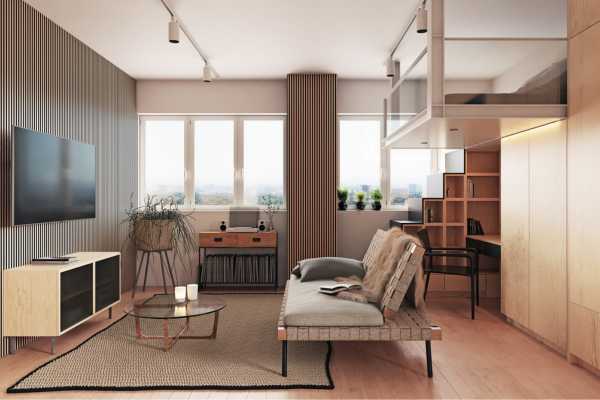In recent times, the trend of compact living, particularly in tiny houses, has gained considerable momentum worldwide.
These diminutive dwellings, characterized by their minimalist design, have captured the fascination of many individuals seeking a simpler and more sustainable lifestyle.
What often goes unnoticed, however, is the sophisticated technology concealed within these quaint abodes, which not only enhances their charm but also ensures their functionality.
Independent Energy Systems
One of the remarkable aspects of tiny homes is their capacity to function off the grid. Many tiny homeowners are embracing innovative electrical setups that reduce their dependence on conventional utilities.
For instance, integrating solar panels discreetly into the tiny house’s design enables the capture of sunlight, converting it into electricity to power essential appliances.
Moreover, advanced battery storage solutions enable the storage of surplus energy for use during periods of low sunlight or at night, ensuring a consistent power supply.
Intelligent Space Optimization
Living in a tiny house necessitates inventive solutions for maximizing space, and concealed technology plays a pivotal role here. Ingeniously designed furniture such as foldable tables, retractable beds, and wall-mounted storage units empower residents to make the most of every square inch available.
Furthermore, some tiny homes are equipped with voice-controlled smart assistants, allowing occupants to manage various aspects of their living environment effortlessly, thereby simplifying daily routines.
Sophisticated Climate Management
Irrespective of its size, maintaining a comfortable indoor climate is paramount in any dwelling. Tiny houses are outfitted with advanced climate control systems that regulate temperature and humidity levels optimally.
State-of-the-art thermostats, accessible remotely via smartphone apps, empower residents to pre-adjust the temperature before their return, conserving energy and ensuring a pleasant ambiance upon arrival.
Sustainable Water Usage and Reclamation
Environmental consciousness is central to tiny house design, with water conservation ranking high on the agenda. Concealed technologies such as rainwater harvesting systems and greywater recycling units enable efficient collection and reuse of water resources.
Filtration and purification mechanisms guarantee the safety of the water for various purposes, ranging from drinking to bathing. By leveraging these systems, occupants of tiny houses can significantly diminish their ecological footprint.
Advanced Security Measures
Despite their compact dimensions, safety is never compromised in tiny houses. Many owners invest in cutting-edge security systems to safeguard their homes and provide peace of mind.
These systems often encompass surveillance cameras, motion sensors, and smart locks, which can be monitored and controlled remotely.
Besides deterring potential intruders, these security measures serve as invaluable resources during emergencies, promptly alerting homeowners and authorities to unforeseen incidents.
Innovative Waste Management Solutions
Effective waste disposal poses a challenge in small living spaces, yet concealed technology offers practical solutions. Composting toilets are gaining popularity in tiny homes, offering a sustainable alternative to conventional flush toilets.
These innovative systems decompose waste into compost, which can then be utilized as fertilizer, thus closing the nutrient cycle and reducing overall environmental impact.

In Conclusion
In essence, the tiny house movement transcends mere downsizing; it represents a paradigm shift towards embracing simplicity, sustainability, and efficiency.
Beneath the charming facade of these diminutive dwellings lies a trove of concealed technology, facilitating a lifestyle that is both eco-conscious and comfortable.
As more individuals embrace the ethos of tiny living, these innovative solutions are poised to evolve further, underscoring the adage that good things indeed come in small packages.
Keep reading our articles:
Exploring the Appeal of Unique Roofs in Tiny Houses
The Magic of Colors: Choosing the Perfect Palette for Your Home
FAQ
1. What constitutes hidden technology in compact residences?
Hidden technology in micro dwellings encompasses the integration of advanced features aimed at enhancing functionality, durability, and comfort.
These include off-grid energy systems, innovative space-saving solutions, climate control mechanisms, water efficiency and recycling systems, sophisticated security measures, and progressive waste management options.
2. Why are off-grid energy systems favored in tiny homes?
Off-grid energy systems, such as solar panels and battery storage, are favored in tiny homes to reduce reliance on traditional utilities.
By harnessing sustainable energy sources, tiny homeowners can achieve self-sufficiency while minimizing their environmental footprint.
3. What are some smart space-saving solutions for compact homes?
Smart space-saving solutions for tiny residences encompass creative furniture designs and layout strategies that optimize available space.
Examples include collapsible furniture, multipurpose fixtures, and modular storage solutions, all of which maximize functionality within limited square footage.
4. How does climate control work in a tiny house?
Tiny houses employ intelligent climate control systems to regulate indoor temperature and humidity levels.
These systems typically feature programmable thermostats and remote control capabilities, allowing occupants to adjust settings conveniently, even when away from home.
5. What is the significance of water efficiency and recycling in tiny house living?
Water efficiency and recycling initiatives in tiny homes play a crucial role in minimizing environmental impact and promoting sustainability.
By implementing rainwater harvesting systems, greywater recycling units, and advanced filtration technologies, occupants can reduce water consumption and contribute to conservation efforts.
6. How do advanced security measures enhance safety in tiny houses?
Advanced security measures, such as surveillance cameras, motion sensors, and smart locks, bolster safety in tiny houses by deterring intruders and alerting homeowners to potential threats.
These systems provide peace of mind and ensure prompt response to emergencies.
7. What are the benefits of composting toilets in compact living spaces?
Composting toilets offer an eco-friendly alternative to traditional flushing toilets in tiny homes.
By converting waste into compost, these systems minimize water usage, reduce sewage discharge, and promote sustainable waste management practices, aligning with the ethos of environmentally conscious living.


